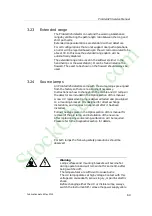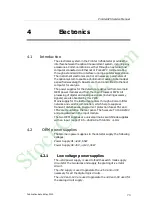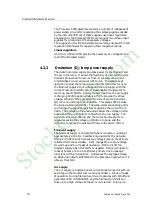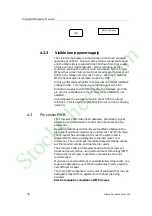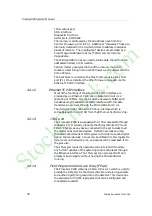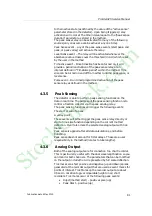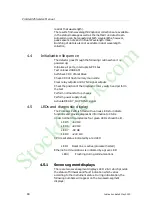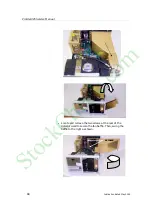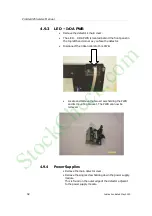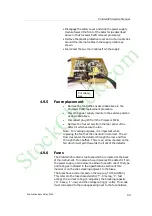
ProStar325 Service Manual
Publication date 8 May 2003
83
4.3.7
Calibration
The electronics on the Processor PWB do not require any manual
calibration. The instrument does however perform self-
calibration at power-on.
4.3.7.1
Gain Calibration
A Gain calibration is performed by the detector at power on. It is
applied across the entire wavelength range at 2nm intervals.
This calibration routine relates to the photometric signal level
present at the output of the signal amplifier circuit. This op-amp
has a possible 15-stage gain arrangement which is selected
electronically depending on signal strength. The detector scans
the spectrum and sets an electronic gain for each wavelength
interval which will correspond to 80% full-scale deflection on the
ADC circuit. Upon completion the detector will perform an
Autozero.
The gain versus wavelength information is stored in volatile
memory and cleared when power is removed and recalculated
again during detector initialization. The calibration data can be
downloaded as a CSV file and be plotted and used for diagnostic
purposes.
Refer to the diagnostics section for more details.
4.3.7.2
Wavelength Calibration
When the detector receives a command to calibrate the
wavelength, it goes through the following sequence of events;
•
Switch on the D2 lamp
•
Scan and find zero order and 656.1nm peak
•
Calibrate the wavelength with a linear calibration from
zero through to 656.1nm
•
Store the calibration into EEPROM
In any event of failure to complete the calibration, the previously
stored calibration will remain valid.
If the D2 has an error or is not available, calibration will not
proceed and an error will be returned.
Refer to the Diagnostics section on how to perform a wavelength
calibration.
4.3.8
Dual Wavelength
The detector provides a command to enable the dual wavelength
configuration (an option provided through a customer
“installation program”). The detector will then save the dual
wavelength configuration in EEPROM. The detector then
provides a command to enable dual wavelength operation for the
method collection. The dual wavelength mode is enabled only if
the configuration allows it and the method allows it.
The detector will provide a command to specify the second
wavelength. When enabled, the detector collects data from
wavelength#1 and wavelength#2 “concurrently” (read at
wavelength#1 and then immediately slew to wavelength#2 and
StockCheck.com
Summary of Contents for ProStar 325 UV-Vis
Page 9: ...ProStar325 Service Manual Publication date 8 May 2003 9 S t o c k C h e c k c o m ...
Page 19: ...ProStar325 Service Manual Publication date 8 May 2003 19 S t o c k C h e c k c o m ...
Page 34: ...ProStar325 Service Manual 34 Publication date 8 May 2003 S t o c k C h e c k c o m ...
Page 71: ...ProStar325 Service Manual Publication date 8 May 2003 71 S t o c k C h e c k c o m ...
Page 72: ...ProStar325 Service Manual 72 Publication date 8 May 2003 S t o c k C h e c k c o m ...
Page 118: ...ProStar325 Service Manual 118 Publication date 8 May 2003 S t o c k C h e c k c o m ...
Page 149: ...ProStar325 Service Manual Publication date 8 May 2003 149 S t o c k C h e c k c o m ...

